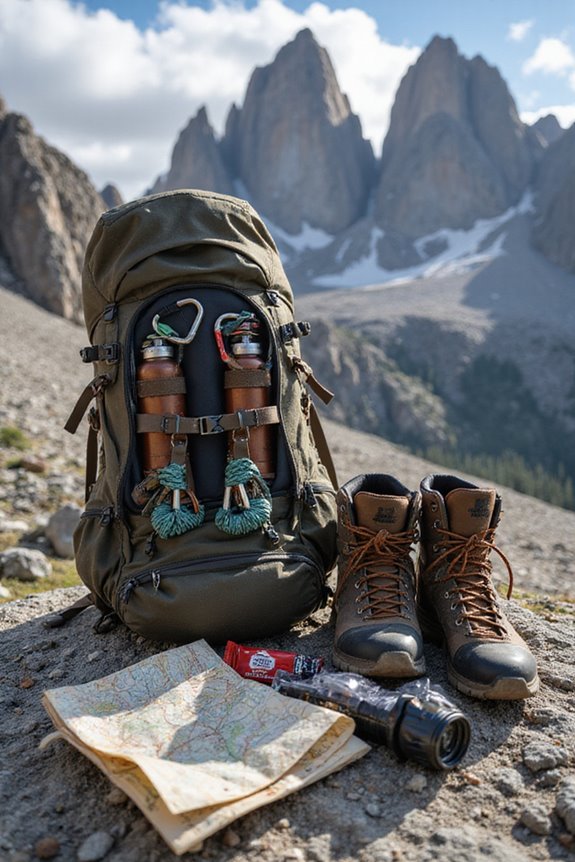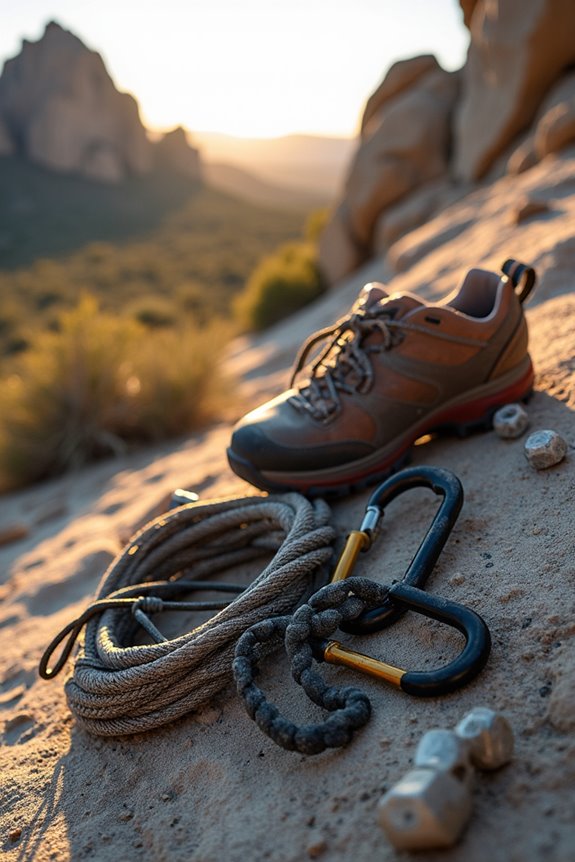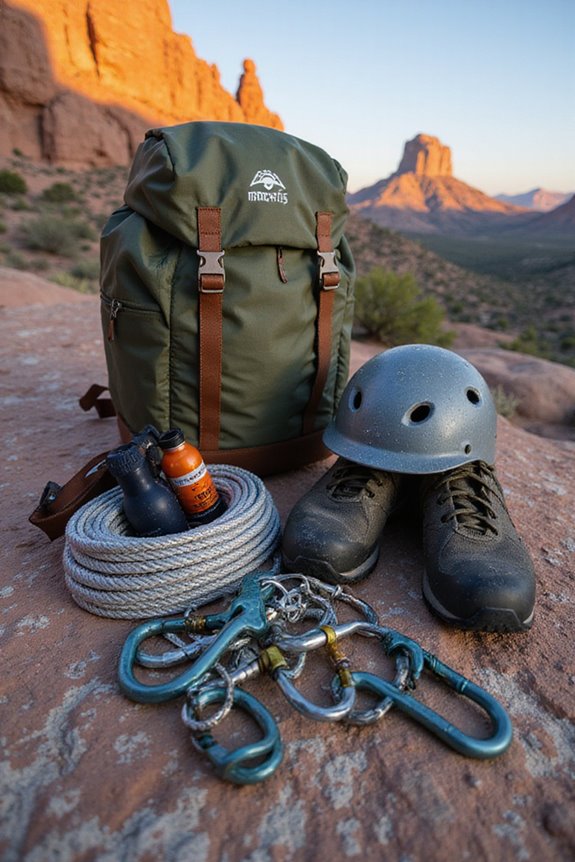When we hit the trails for mountain climbing, packing smart is key! We need quality base layers, sturdy technical gear, and versatile clothing layers to stay dry and warm. Don’t forget essential climbing tools, ropes, and navigation devices to keep us on track. A cozy tent and warm sleeping pad for overnight stays? Absolutely! And let’s not skip high-calorie snacks to fuel our adventure. Trust me, we’ll tackle those peaks together—and there’s plenty more to uncover about this incredible journey ahead!
Key Takeaways
- Pack essential clothing layers, including moisture-wicking base layers, insulating mid layers, and weather-resistant outer layers for protection.
- Bring technical climbing equipment like protection devices, quickdraws, locking carabiners, and trekking poles for safety and stability.
- Choose the appropriate ropes, ensuring proper maintenance, with a sturdy single rope for sport climbing or agile half ropes for trad routes.
- Include navigation tools such as a handheld GPS, compass, and emergency communication devices for safe exploration in the wilderness.
- Don’t forget overnight gear, such as a durable tent, insulated sleeping pad, lightweight stove, and bear canister for food storage.
Essential Clothing Layers
When it comes to mountain climbing, the right clothing layers can make all the difference between a great adventure and a frozen misery. We’ve learned that starting with quality base layers sets the tone. Moisture-wicking materials like merino wool keep us dry and warm. Next up are mid layers, where fleece or soft-shell jackets bring insulation and breathability to the party. Then there are outer layers—hardshell jackets and rain pants—offering that essential shield against the elements. Don’t forget versatile headwear options and proper hand protection; cold digits are no fun! Footwear choices are crucial too—layering socks helps avoid blisters. For extreme conditions, consider heavyweight fabrics that trap heat effectively while maintaining breathability for intense mountain activities. Trust us, when we layer smartly, we embrace the freedom of summits without risking frostbite or discomfort!
Technical Climbing Equipment
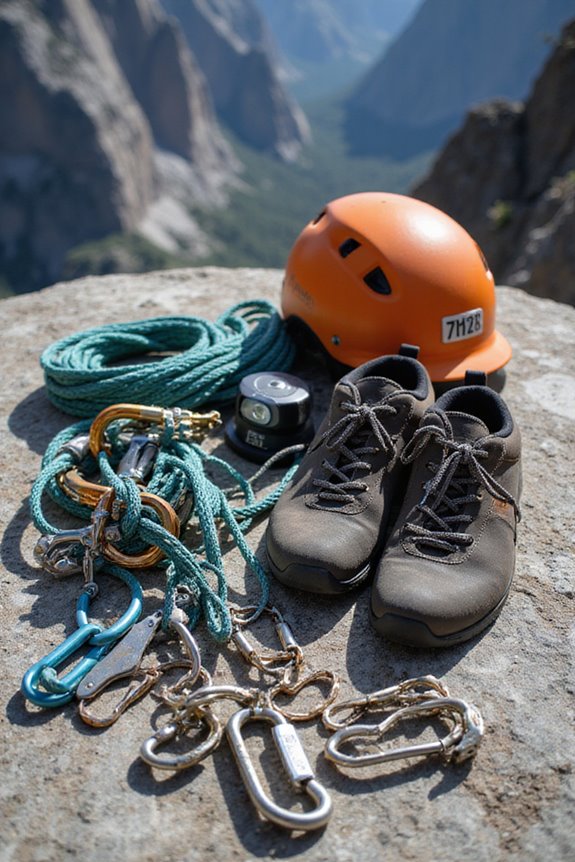
No one likes to be caught unprepared on a climb, especially when the right gear can make or break our adventure! When it comes to technical climbing equipment, we’ve got to prioritize our protection devices. Cams and nuts are essential; they’ll fit snugly in cracks and keep us secure. Don’t forget those quickdraws— the unsung heroes of our climbing gear— that’ll help us clip into bolts effortlessly. For longer routes, alpine draws reduce rope drag like magic, and runners can save us from awkward moments on belays. And let’s not overlook locking carabiners; they’re our safety net, preventing any accidental mishaps. Adjustable trekking poles can provide crucial stability and balance on challenging terrain approaches, with the best options featuring lightweight aluminum construction and reliable locking mechanisms. With these trusty tools, we’re set for a thrilling journey and ready to embrace the freedom of the mountains!
Ropes and Climbing Tools
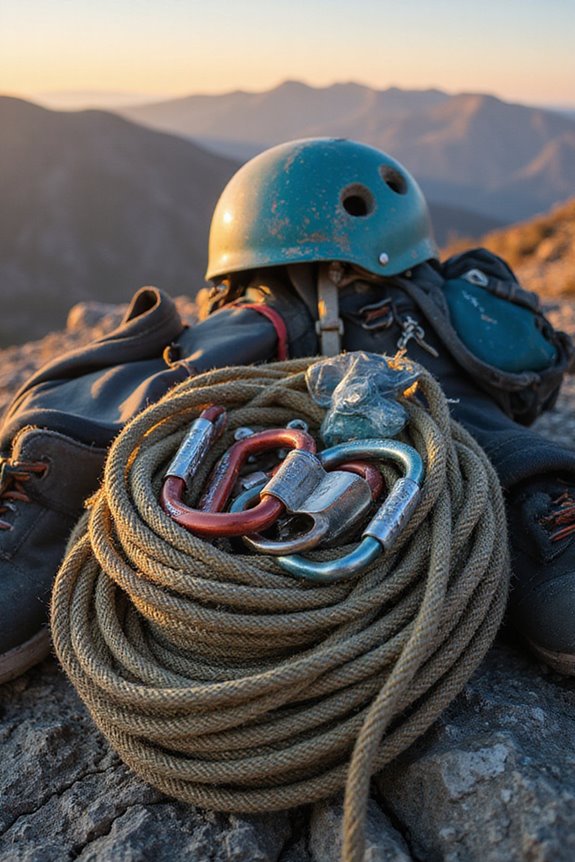
While we’re gearing up for an epic mountain adventure, let’s talk about the ropes and climbing tools that will keep us safe and soaring. Choosing the right rope types—whether it’s a sturdy single rope for sport climbing or agile half ropes for trad routes—can make all the difference. Don’t forget to perform regular rope maintenance; inspect for cuts and wear before each ascent so we can trust our lifeline.
Along with ropes, we need essential tools like our harness, belay device, and locking carabiners. These goodies help us manage the climb while staying safe. Consider adding a portable camping stove weighing only 110-240 grams to enjoy hot meals after your challenging climbs. If you’re like us, the thrill of scaling peaks calls for well-maintained gear—let’s keep our journey fun, adventurous, and most importantly, safe!
Navigation and Communication Devices
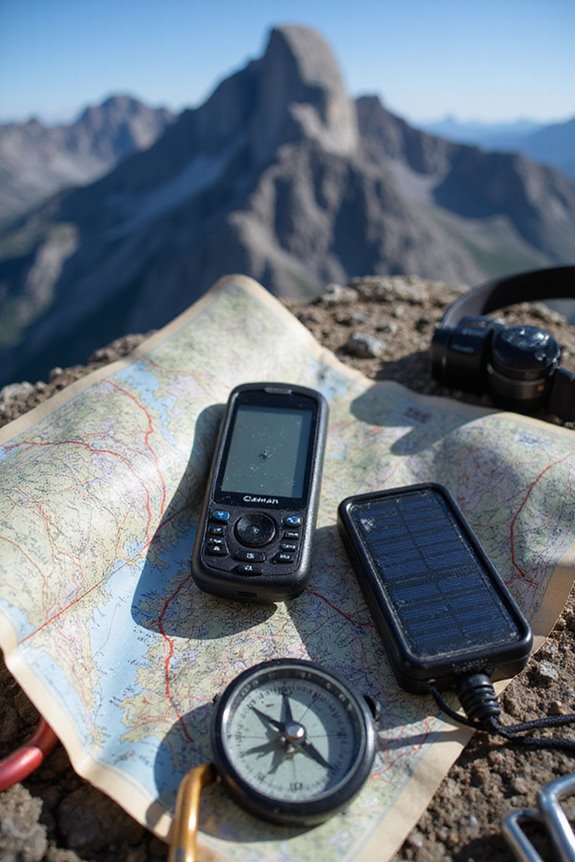
Navigation and communication devices are absolutely essential for any mountain climbing adventure, and trust us, you want to be equipped with the right gear! First things first, let’s prioritize navigation redundancy: a reliable GPS device paired with a compass and a physical map creates a foolproof system. We carry our trusty handheld GPS for precise positioning, but that old-school compass? It’s a lifesaver when electronics fail!
And for emergency communication, we don’t leave home without our personal locator beacon or satellite messenger. These gadgets let us send SOS alerts when we lose cell service—because let’s face it, nobody wants to be the one lost in the mountains! When selecting a PLB, consider devices like the ACR ResQLink 400 which offers GPS tracking capabilities combined with a bright strobe light and loud whistle for maximum rescue potential. With these tools, we’re ready to embrace our freedom and explore the wild safely!
Overnight and Camping Gear
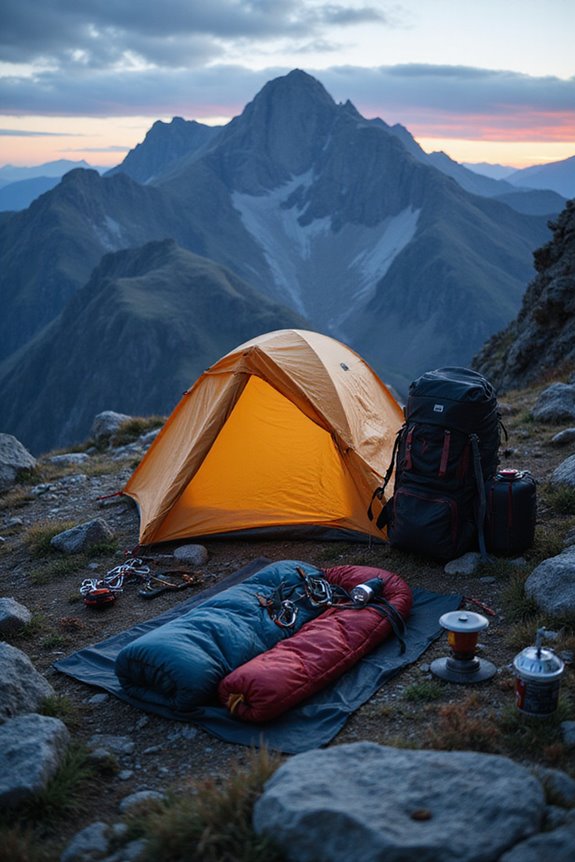
When we hit the trails for a mountain climbing adventure, packing the right overnight and camping gear is essential for our comfort and safety. We need a durable, four-season tent and an insulated sleeping pad to keep us warm and cozy, even at 0°F or colder. Look for tents with high waterproof ratings of at least 3000mm to ensure protection against all weather conditions. Let’s not forget our ultralight backpacking stove and high-calorie meals to fuel our wild spirits!
Now, as for storage solutions, a solid food storage system, like a bear canister, keeps our supplies safe from wildlife—because sharing your snacks with bears isn’t a fun adventure. And don’t skimp on camp shoes; trust me, our tired feet will thank us! With the right camping gear, we’re set for an exhilarating night under the stars!
Safety and Rescue Equipment
As we gear up for our mountain climbing escapades, packing the right safety and rescue equipment can make all the difference between an unforgettable adventure and a harrowing tale. We can’t stress enough how vital avalanche safety gear is! An avalanche beacon helps us locate each other in snow, while a probe pole and shovel are essential tools for digging out victims—because nobody wants to play hide and seek in the snow.
Don’t forget a sturdy helmet and a certified climbing harness; they’re our best friends in preventing falls. Plus, a thorough first-aid kit is a must; nothing ruins freedom faster than a twisted ankle! We should also pack two-way radios for communication. When we’re prepared, we’re free to chase thrills without worries!
Footwear and Accessories
Packing the right footwear and accessories can make or break our mountain climbing adventure! We’ve gotta consider various boot types suited for our climbing needs. Whether it’s sturdy single boots for glacier travel or those ultra-insulated double boots for high altitudes, the choice is key. Plus, layering our socks with a moisture-wicking liner and a thick mountaineering sock keeps our toes toasty and dry. Don’t forget essential accessories like gaiters to fend off that pesky snow and moisture! And let’s not overlook comfy base camp footwear for our off-the-mountain chill-outs. A pair of lightweight crampons that fit our boots will guarantee we’re secure on icy trails. That’s freedom in every step we take! Let’s gear up and conquer those peaks!
Food and Hydration Supplies
After gearing up with the right footwear and accessories, we’ve gotta turn our attention to another essential component of our mountain climbing adventure: food and hydration supplies! Packing a meal variety is key—think high-carb tortillas, protein-rich cured meats, and calorie-dense energy bars. Those quick snacks keep our spirits high and muscles fueled!
Now, let’s talk hydration strategies. A minimum of one liter per climber is a must, but let’s not skimp. Electrolyte mixes keep us balanced, too! It’s understood that climbing can be thirsty work, so always pack water purification tools—trust me, melted snow is a game changer.
Frequently Asked Questions
How Do I Choose the Right Climbing Route?
When choosing the right climbing route, we’ll assess our climbing techniques and match them with challenges we’re comfortable tackling. Let’s evaluate routes together, ensuring we’ve got the skills for a safe and thrilling adventure.
What Fitness Level Is Needed for Mountain Climbing?
For mountain climbing, our fitness assessment should really focus on cardiovascular endurance and muscular strength. A solid training regimen mixes running, strength training, and flexibility work, ensuring we’re ready to embrace the adventure ahead.
Can Beginners Participate in Mountain Climbing Trips?
Absolutely, we can participate in mountain climbing trips! With beginner tips and the right climbing gear, we’ll build confidence together, exploring new heights safely and enjoying the exhilarating freedom that comes with every ascent.
How Can I Prevent Altitude Sickness During Climbs?
When we chase the heights, we must master acclimatization techniques and hydration strategies. Let’s embrace the journey, ascend slowly, stay hydrated, and listen to our bodies to experience freedom above the clouds, free from altitude sickness.
What Should I Do in Case of an Emergency?
In an emergency, we’ve got to stay calm and quickly assess the situation. We should utilize communication devices and apply emergency first aid, ensuring we’re ready to signal for help while protecting everyone involved.

